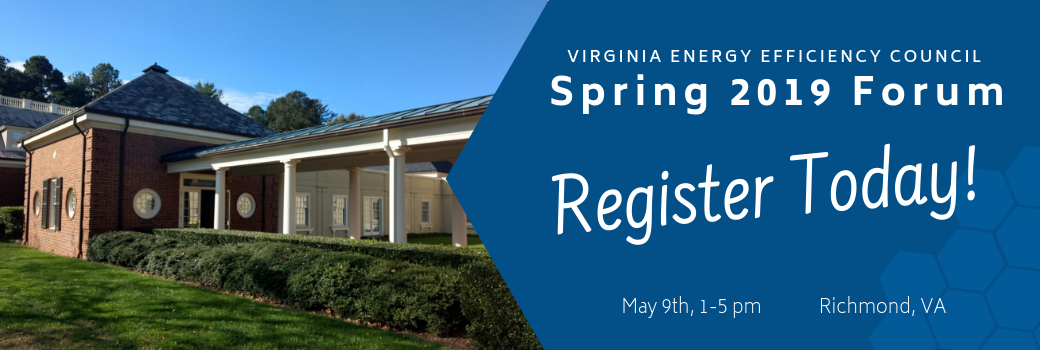This is a guest post from Honeywell, the program manager for Dominion’s newest residential energy efficiency program.
 Residential homeowners looking to make their home more energy efficient in preparation for winter and beyond can benefit from the launch of Dominion Energy Virginia’s new Home Energy Assessment (HEA) Program.
Residential homeowners looking to make their home more energy efficient in preparation for winter and beyond can benefit from the launch of Dominion Energy Virginia’s new Home Energy Assessment (HEA) Program.
HEA is one of 8 programs approved by the State Corporation Commission in support of improving energy efficiency opportunities in Virginia for residential and commercial customers.
Dominion Energy’s residential customers can receive an in-home energy assessment where a qualified participating contractor will conduct a walk-through audit and install simple measures like LED bulbs and water heater pipe insulation, while identifying other energy-saving opportunities in the home. Recommended energy efficiency improvements will be suggested for maintenance and upgrades on heating and cooling systems, ductwork and water heaters through a customized HEA report. Once customers have worked with their contractor to install the recommended improvements, they are eligible to receive valuable rebates that help to offset the cost of service.
 The HEA Program was designed with three simple steps to make it easy to participate:
The HEA Program was designed with three simple steps to make it easy to participate:
- You can schedule an assessment at a time that is convenient for you with the contractor. Visit DominionEnergy.com/HomeEnergy to find a list of participating contractors.
- The contractor conducts a 30 to 60-minute walk-through of the home and installs simple measures, while identifying other energy-saving opportunities
- The contractor works with you to submit the rebate application for work completed
Dominion Energy’s new portfolio of energy efficiency programs were approved to run for a 5-year period through June 2024. Other new residential programs include appliance recycling and efficient products rebates. Non-residential programs provide rebates for energy efficient lighting systems and controls, heating and cooling systems, window film, small manufacturing facilities and office buildings.
All approved programs are part of the $870 million of energy efficiency programs that Dominion Energy is required to propose over a 10-year period, as ordered by the Grid Transformation & Security Act of 2018. The landmark legislation will keep Virginia’s traditional advantage of low electricity prices and reliable service while taking dramatic steps towards the future by expanding renewable energy and broadening the potential for energy efficiency programs in Virginia. If you are interested in learning more about these energy efficiency programs, please visit www.DominionEnergy.com/ECprograms.
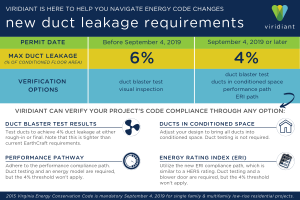 A lot of progress has been made on updating the Uniform Statewide Building Code (USBC) since our last blog post. First, the update that was finalized last year (the 2015 update for anyone who gets really into the weeds on this topic), went into effect earlier this month. Our friends over at Viridiant made a terrific infographic outlining the energy changes in that update and are hosting several compliance trainings across the state.
A lot of progress has been made on updating the Uniform Statewide Building Code (USBC) since our last blog post. First, the update that was finalized last year (the 2015 update for anyone who gets really into the weeds on this topic), went into effect earlier this month. Our friends over at Viridiant made a terrific infographic outlining the energy changes in that update and are hosting several compliance trainings across the state.
Over the summer, VAEEC and some of our members attended DHCD energy subgroup meetings to identify areas of consensus among stakeholders on the current update (the 2018 update for anyone who gets really into the weeds on this topic). You can read about all of the proposals discussed in the initial subgroup meeting in our last blog post on building codes.
We are pleased to announce that VAEEC and our members were able to successfully reach a compromise with the Homebuilders Association of Virginia, and other stakeholders, on several key proposals. The biggest gain is that blower door testing will now be required on all new homes that are constructed after this update goes into effect. Two smaller proposals also made it into the draft USBC- updating REScheck software and requiring a certificate on the electrical box that includes various energy details of the home. These proposals were voted on at the final workgroup meeting and went before the Board of Housing and Community Development who voted to include them in the draft USBC on September 16th.
While our insulation proposal was deferred until next year, we have an agreement with the homebuilders to do a couple of information sessions throughout Virginia with homebuilders to help them better understand what would be required with an increase in the insulation R-value. We hope to see some improvements to the insulation requirements in the final USBC.
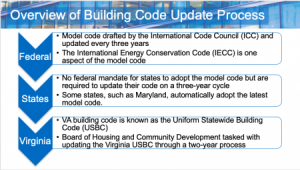 So, what’s next? We are waiting for the draft USBC to be placed in the Virginia Register, which will kick off a 30-day comment period. Then, next year, the entire process begins again as we move into the final phase of this update. The USBC update process is described in detail on our Building Codes page. We even have a handy graphic to explain it.
So, what’s next? We are waiting for the draft USBC to be placed in the Virginia Register, which will kick off a 30-day comment period. Then, next year, the entire process begins again as we move into the final phase of this update. The USBC update process is described in detail on our Building Codes page. We even have a handy graphic to explain it.
This week is National Clean Energy Week! Established in 2017, NCEW focuses on advancing support of our nation’s energy sector through new methods of market development, policy change, and technological innovation. Virginia was the 5th state to formally recognize the event in 2019 in a state proclamation made by Governor Northam.
The Governor made bigger waves in clean energy last week with his announcement at the VA Clean Energy Summit on Executive Order 43, which set forth ambitious goals for the Commonwealth’s energy future. The three part plan includes: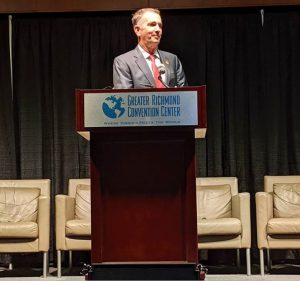
- Objectives for statewide energy production, with the goal of 30% of Virginia’s electric system powered by renewable energy by 2030 and 100% carbon-free power by 2050.
- Lead-By-Example targets for increasing the energy efficiency of Commonwealth agencies and executive branch institutions, with the goal of procuring at least 30% of the power used by those facilities from renewable sources by 2022.
- Development of an energy workforce plan that supports the growing needs of the energy efficiency and renewable energy sectors.
“This is a positive step forward for the energy efficiency industry in Virginia,” said our Executive Director, Chelsea Harnish. “We applaud the Governor for prioritizing workforce development and advancing energy efficiency jobs across the Commonwealth.” The energy efficiency industry currently accounts for over 78,000 jobs in Virginia, and is projected to continue growing by 7.8%.
The Executive Order was just one of the many topics discussed at the VA Clean Energy Summit (VACES). The sold-out inaugural event brought together over 400 professionals from every part of the clean energy industry to learn and network, with 14 breakout sessions, two plenary panels, and two keynote speakers. VAEEC was one of the five host organizations that put on the Summit. In the first plenary panel of the day, Virginia’s Transforming Electricity Grid, David Farnsworth from Regulatory Assistance Project said, “As far as what [work] needs to happen when, I say efficiency first, always.”
Now that the VACES has passed, what can you do to celebrate NCEW?
- Register for the VAEEC Fall 2019 Forum to learn even more about the industry’s future
- Apply for a Virginia Energy Efficiency Leadership Award by Friday
- Call your Senators and Delegates and let them know you support the Executive Order and clean energy in Virginia
- Share pictures and impressions from the VACES and tag #vacleanenergysummit and VAEEC on social media
- Switch to LED light bulbs and install a smart thermostat in your home or office
- Visit one of the LEED certified attractions in VA
Andrew Grigsby of VA-REA said, “The California and Hawaii grids were not built for clean energy saturation, but they have been able to get there because it’s not just renewables. It’s all these pieces (of the industry) working together.”
School is back in session! Children across the Commonwealth are packing their bags, readying their clothes, and preparing for a new journey in their educational career. As we enter a new academic year now is a great time to teach and incorporate energy-efficient practices into your child’s everyday learning! Kids are the future and what better way to increase awareness and make a difference than starting with our future.
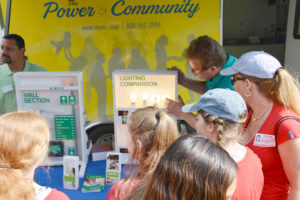
Virginia Energy Sense’s third-grade energy efficiency curriculum, which won “Committee’s Choice Award” at VAEEC’s 2018 Virginia Energy Efficiency Leadership Awards, was developed in partnership between the State Corporation Commission and the Virginia Department of Education and designed to meet the Standards of Learning (SOL). Students go through interactive lessons that teach them how to easily and cost-effectively save energy as well as how to take an active role in promoting change at school and home. These interactive lessons include energy efficiency matching games, crossword puzzles, home and school energy checklists, quizzes and interactive foldable booklets and poster design plans. The knowledge that students gain through these lessons can then be transferred to their parents, friends, family members, and others outside of their classroom. You can read more about the curriculum in Virginia Energy Sense’s official press release.
Outside of the classroom, there are many resources you can use to get kids involved in energy efficiency. Interactive websites such as Apogee Interactive Energy Efficiency Kids Korner, Energy Star Kids, and EIA Energy Kids layout energy efficiency information in a kid-friendly manner and provides interactive games and activities for their entertainment. There are also many kid-friendly videos such as this short titled “Energy, let’s save it!” on Youtube.
Ensuring energy efficiency and environmental protection starts with you and the people around you. Help out our planet by learning more and raising awareness among you, your friends, and your family!
Virginia is home to a huge selection of attractions and locations to visit and spend your leisure time, many of which offer the added benefit of being energy-efficient! As the summer winds down, you’re probably considering a last-minute vacation for the Labor Day weekend. Read up on a few special locations that have been awarded LEED certification for their efforts in energy-efficiency.
Brock Environmental Center
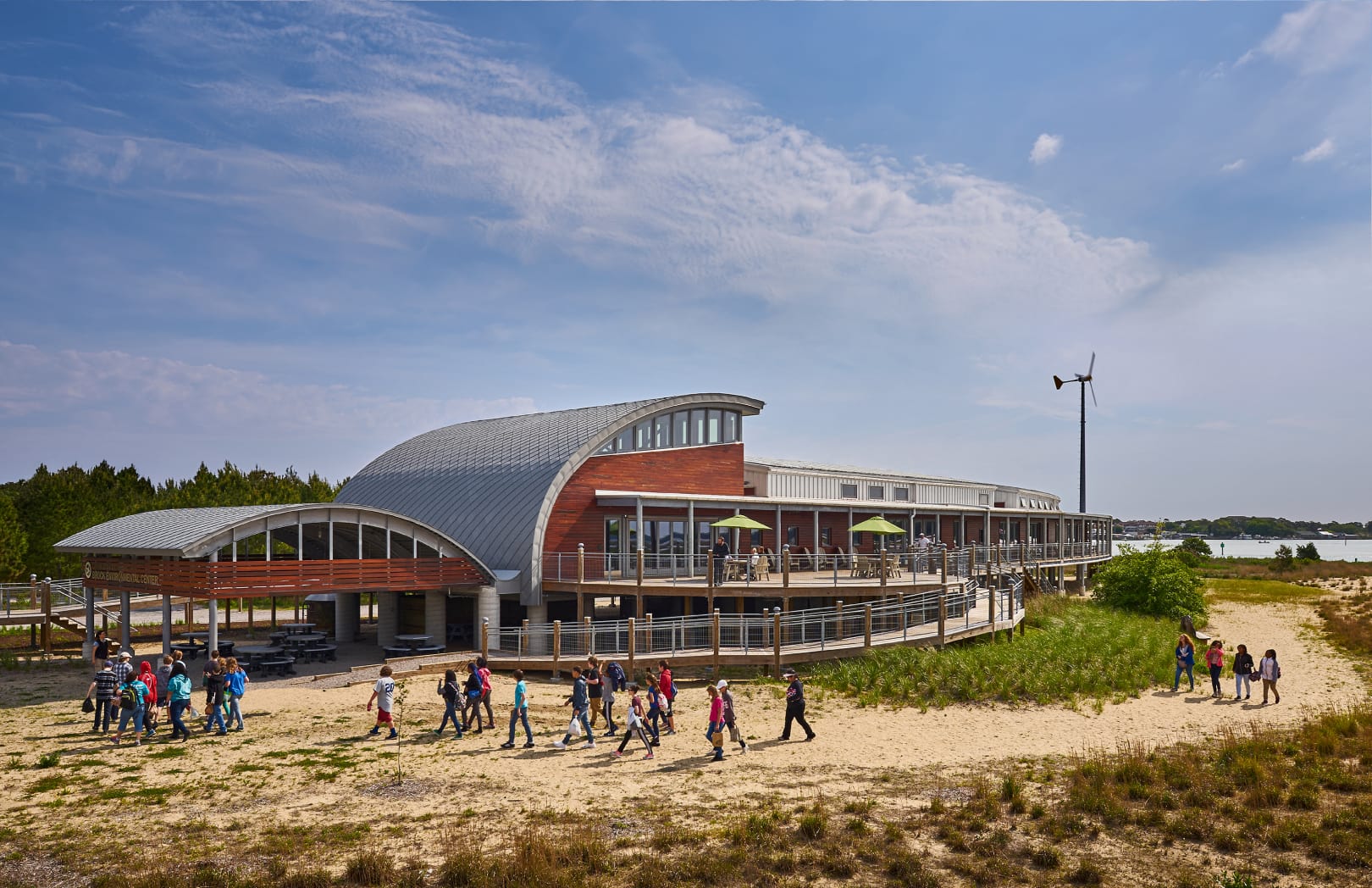
Located in the City of Virginia Beach, the Chesapeake Bay Foundation(CBF)’s Brock Environmental Center has been described as a must-see destination for anyone who is interested in seeing how infrastructure and nature can thrive side by side. The Brock Environmental Center serves as the CBF’s regional base of operations to offer its award-winning environmental education programs to 2,500 students and teachers each year and provides space for other local conservation partners, community meetings and special events.
The project has seen some truly remarkable feats. “In the past year, the Center has produced about 83 percent more energy than it has used. The building also uses 90 percent less water than a typical office building of its size. And as a result . . . uses 80 percent less energy than a typical building that size.”
The building has achieved LEED Platinum certification from the U.S. Green Building Council and Living Building Challenge certification from the International Living Future Institute. Platinum certification designates the Center has scored 80+ points across categories that include: Location & Transportation, Sustainable Sites, Water Efficiency, Energy & Atmosphere, Materials & Resources, Indoor Environmental Quality, Innovation and more. The Living Building Challenge certification requires a building to produce more energy than it uses over the course of 12 consecutive months and maintains strict criteria for water use, location, health, materials, equity, and beauty.
3663 Marlin Bay Drive, Virginia Beach, VA
https://www.cbf.org/about-cbf/locations/virginia/facilities/brock-environmental-center/
Clark Hall – University of Virginia

While visiting the University of Virginia (UVA) campus in Charlottesville, be sure to ask your tour guide for a look inside Clark Hall, a historic that went through a series of retrofits and renovations as part of the university’s pledge to energy-efficiency. Once home to the school of law, the current Department of Environmental Sciences “serves as an unsurprising candidate to lead UVA’s energy conservation efforts by example.”
Within Clark Hall, UVA began its Better Buildings Challenge by converting all of the building’s 5,000 interior and exterior lighting fixtures from fluorescent to LED, installing low-flow toilets and faucets, re-calibrating air handling units and upgrading HVAC controls. The resulting impact saved UVA about $770,000 in energy and water savings, and 3,000 tons of carbon emissions per year! Quite fitting for the building that houses the Department of Environmental Sciences.
291 McCormick Rd, Charlottesville, VA 22903
https://www.virginia.edu
Virginia Beach Convention and Exhibition Center
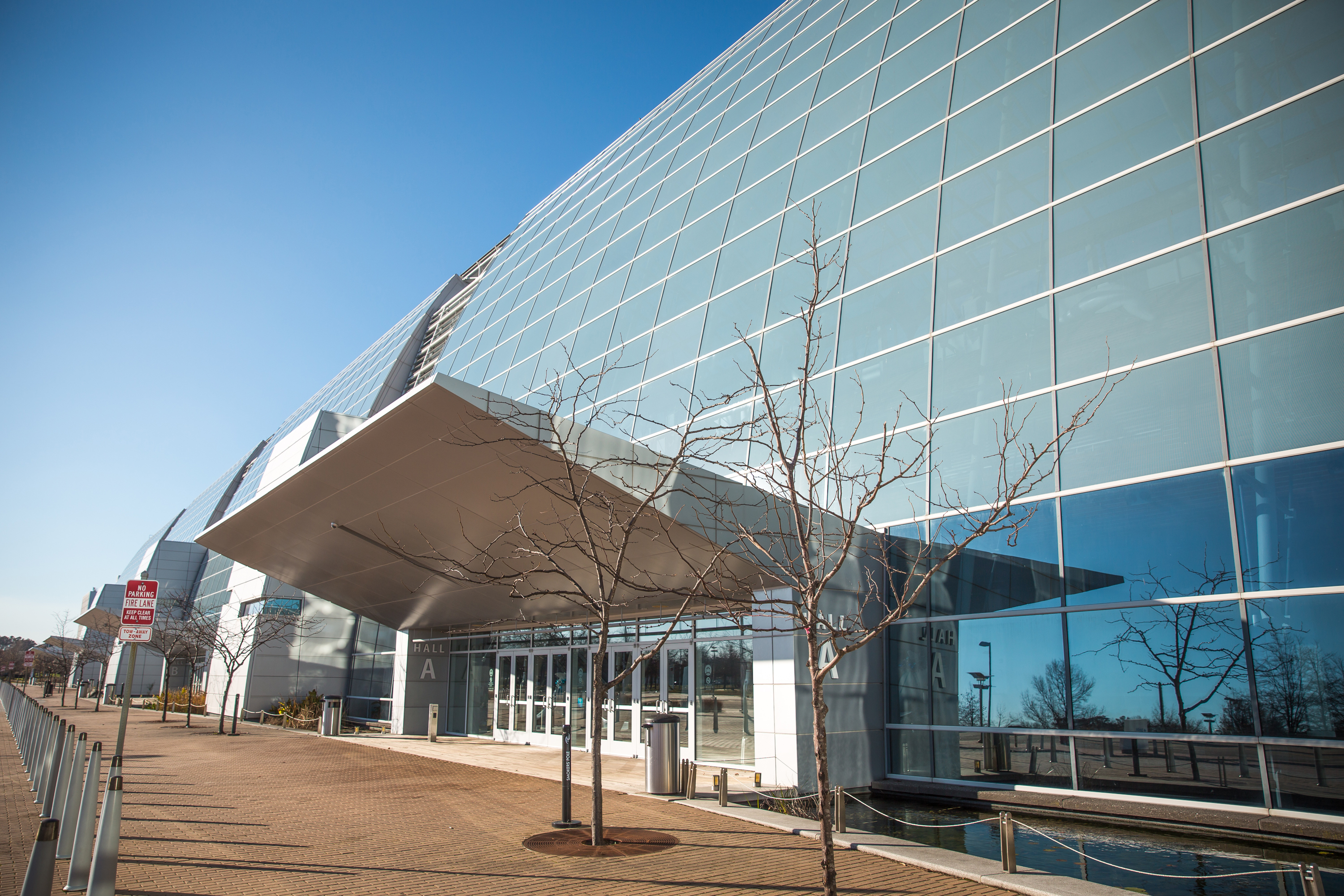
Located within walking distance of the beach, the Virginia Beach Convention Center (VBCC) is publicly owned and maintained by the City of Virginia Beach. Having earned a LEED Gold in the Existing Buildings category, its when renovations helped better serve its capacity of 18,000 while more effectively manage its carbon footprint. 85 percent of the work done to achieve LEED certification was completed by the City of Virginia Beach staff, a testament to the manpower Virginia Beach has to offer.
“The upgraded building automation system provides real-time thermographic color images to illustrate occupant comfort and provides live energy use data. In addition, an on-site vegetable garden, improved water efficiency, and the annual diversion of more than 140 tons of waste from the landfill helped VBCC earn necessary certification points.”
Address: 1000 19th St, Virginia Beach, VA 23451
https://www.visitvirginiabeach.com/convention-center/
Cooper Vineyards

Trips to the vineyard are an excellent way to enjoy the surrounding community one glass at a time, and knowing it was managed in an energy-efficient manner should put your mind even more at ease. You’d achieve exactly that when you delight in a glass of Noche at Cooper Vineyards LEED Platinum certification in 2012 for their environmentally-friendly tasting room. As the Green Badger described it, “the architectural design of the tasting room, with two complete walls of glass that extend up for two stories, makes the visitor experience that of an “indoor/outdoor” space regardless of the weather.”
Cooper Vineyards boasts a nearly 5,000-square-foot building that deserves recognition for its strides in energy efficiency as well. The building holds the vineyard’s offices, kitchen, and tasting room mentioned earlier, and includes a 3,000-gallon tank rainwater harvesting system, a Structurally Insulated Panel System (SIPS), solar power panels, and several 30-foot indoor solar-light harnessing tubes.
13372 Shannon Hill Rd, Louisa, VA 23093
http://www.coopervineyards.com/
Henrico County Public Libraries

Henrico County Public libraries are essential information hubs for their communities. They offer access to resources that can change lives, at no additional fee. Maintaining a library’s many books, computers, videos, conference spaces, learning programs, and more can be energy-intensive. Four of Henrico’s libraries have created a benchmark on implementing energy-efficient practices into their building implementation; the Gayton Branch Library, Glen Allen Branch Library, Libbie Mill Area Library, and Varina Area Library have all reached LEED certification for multiple designs.
After a renovation project that included building automation HVAC systems, high-efficiency sink fixtures, alternative transportation parking, and environmentally conscious material selection, each library was able to reduce water consumption by an average of 42% and energy consumption by 32% with its renovations. Additionally, 90% of construction waste was diverted from landfills! Glen Allen Branch Library was the first of the four to finish renovations in 2010. with Varina finishing up in 2016 and was recognized in 2017 by the American Institute of Architects and the American Library Association for excellence in library design. The new library offers Varina area residents many new and improved services in a beautiful setting while reinforcing Henrico County’s commitment to environmental stewardship.
Gayton

10600 Gayton Rd, Henrico, VA 23238
https://henricolibrary.org/gayton
Glen Allen

10501 Staples Mill Road, Glen Allen, VA 23060
https://henricolibrary.org/glen-allen
Libbie Mill
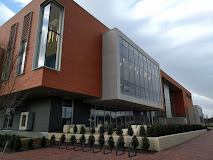
2100 Libbie Lake East St,
Henrico, VA 23230
https://henricolibrary.org/libbie-mill
Varina

1875 New Market Road
Henrico, VA 23231
https://henricolibrary.org/varina
Nationals Park
/cdn.vox-cdn.com/uploads/chorus_image/image/53974235/usa_today_9234991.0.jpg) Baseball fans and Washington D.C. natives alike will be familiar with the home to the MLB team, the Washington Nationals. Nationals Park has the distinction of being the first Major League Baseball stadium with LEED certification!
Baseball fans and Washington D.C. natives alike will be familiar with the home to the MLB team, the Washington Nationals. Nationals Park has the distinction of being the first Major League Baseball stadium with LEED certification!
Built on a brownfield, a lot of care was put into incorporating the stadium into D.C. while minimizing its energy use and resource waste production. Efficient field lighting, external shading, additional shading, low-flow faucets and dual-flush toilets, a 6,300-square-foot green roof over the left-field concession and restroom areas, and stormwater filtration systems help improve the efficiency and quality of the experience offered to its 1,000,000+ sqft. Campus.
1500 S Capitol St SE, Washington, DC 20003
https://www.mlb.com/nationals/ballpark
While you enjoy your next vacation or weekend adventure in Virginia, be sure to learn about how it provides the quality service you love, with the attention to energy and resources that benefit everyone! Know about a location/attraction that has taken strides to remain energy efficient? Email us at info@vaeec.org
Summer is here and with it comes the opening of the Virginia Energy Efficiency Leadership (VEEL) Awards application. Held in conjunction with the VAEEC Fall Forum, the VEEL Awards Luncheon will be held on Thursday, November 14th at the University of Richmond’s Jepson Alumni Center.
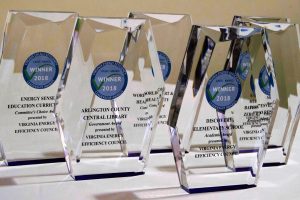
2018 VEEL Awards
For the fourth consecutive year, the awards showcase energy efficiency champions across the Commonwealth. These entities are helping businesses, governments, homeowners, and schools save money on energy bills while reducing energy consumption – all while stimulating Virginia’s job growth and our economy.
This year, submissions will be placed into one of six categories. Submitted projects will be sorted based on the sector served: Academic, Commercial, Government, Low-Income, and Residential. Submitted programs will be placed into their own category. Projects can include, but are not limited to, retrofits, new construction, and innovative technologies or products. Past winning programs include Chesterfield County’s Energy Management Program, Columbia Gas of Virginia’s WarmWise Home Audit program, and the Virginia Department of Mines, Minerals and Energy’s Virginia SAVES program.
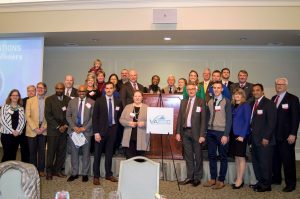
2018 Awards Winners
The quick and free online application process opens on Monday, July 15th and will run through Monday, September 16th. Nominate an acquaintance, a colleague, a role model, or yourself! The only criteria are that the project or program is based in Virginia and is reducing energy consumption. Extra points are given for innovation and creativity, the degree of difficulty in overcoming challenges, and scope of work.
Still have questions? To help you submit your application, we have compiled a guidance document, which includes submission requirements, the application of a previous awards winner, the scorecard with rubric, and frequently asked questions.
We look forward to learning about your energy efficiency contributions. Best of luck!
For a recap of our 2018 VEEL Awards, check out this blog post.
Back in 2017, VAEEC conducted a Strategic Planning Retreat to help the VAEEC staff and Board set goals and priorities for the organization that helped us strengthen our operations, focus our resources, and assess our direction over the last two years. Fast forward to 2019, and it is time to start the process over again.
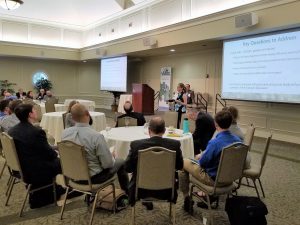 VAEEC is now in the midst of creating a strategic plan for the next three years. During our Spring 2019 Forum, attendees participated in an interactive session designed to provide feedback as we began this process. Participants self-selected into one of four breakout groups: Emerging Technologies, Grid Modernization and Transformation Act (GTSA) Implementation, the Intersection between Solar and Energy Efficiency, and Local Government Collaboration. Questions discussed included:
VAEEC is now in the midst of creating a strategic plan for the next three years. During our Spring 2019 Forum, attendees participated in an interactive session designed to provide feedback as we began this process. Participants self-selected into one of four breakout groups: Emerging Technologies, Grid Modernization and Transformation Act (GTSA) Implementation, the Intersection between Solar and Energy Efficiency, and Local Government Collaboration. Questions discussed included:
- Why is this topic important to Virginia’s EE industry?
- What are the opportunities?
- What are the barriers?
- What role should VAEEC play?
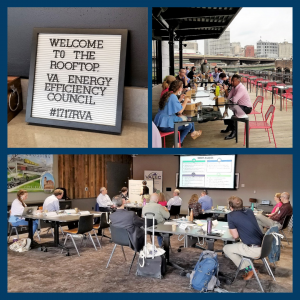 Information gathered from this session was used to inform VAEEC staff and Board during our 2019 Strategic Planning Retreat held on June 5th. During this full-day event, we partnered with Floricane, a Richmond-based facilitation group, to better define the four topics and to come up with outcomes and strategies for each.
Information gathered from this session was used to inform VAEEC staff and Board during our 2019 Strategic Planning Retreat held on June 5th. During this full-day event, we partnered with Floricane, a Richmond-based facilitation group, to better define the four topics and to come up with outcomes and strategies for each.
The graphic below depicts where we currently are in the process of finalizing our strategic plan, as well as what steps remain. VAEEC staff will work over the summer to create tactics and metrics for each of the four strategic outcomes. Once the plan is in draft form, the Executive Committee, comprised of Board officers, will review the plan and offer feedback. The goal is to have the strategic plan finalized by our quarter three Board meeting on September 11th. Once approved, we will share the final plan with our members at our Fall Forum & Awards Ceremony and begin to execute it through 2022.
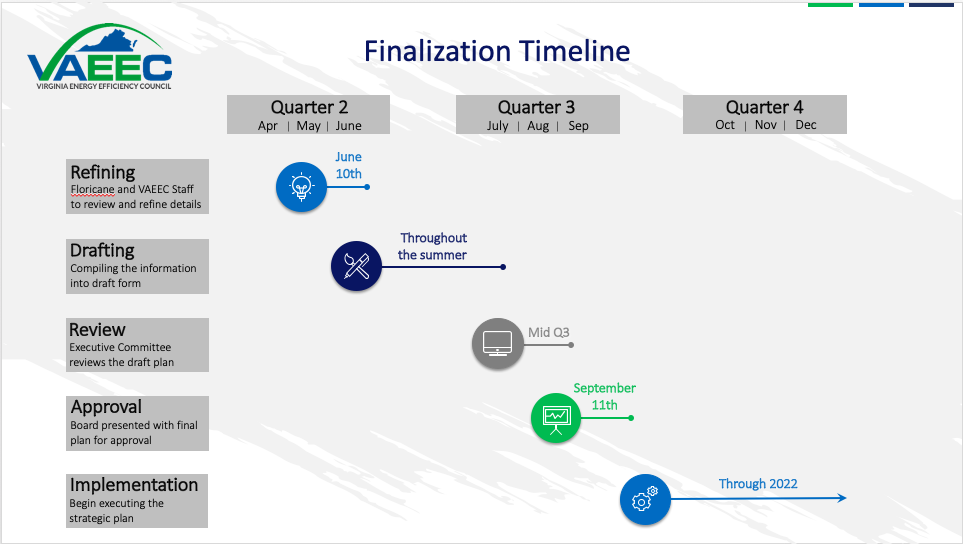
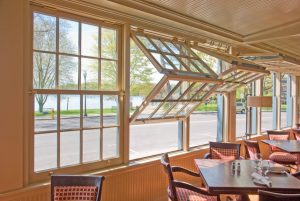 The update process to the Virginia Uniform Statewide Building Code (USBC) has begun*. This is a two year process, which will wrap up at the end of 2020. The Board of Housing and Community Development will hold a public hearing on July 22, 2019 and we encourage our members to attend in support of improvements to the energy code section of the USBC.
The update process to the Virginia Uniform Statewide Building Code (USBC) has begun*. This is a two year process, which will wrap up at the end of 2020. The Board of Housing and Community Development will hold a public hearing on July 22, 2019 and we encourage our members to attend in support of improvements to the energy code section of the USBC.
This spring, DHCD staff established smaller subgroups on key areas of interest, including energy, for the purpose of building consensus on some of the proposals already submitted. VAEEC and several of our members are participating in the energy subgroup, which has already met once. The following energy proposals, which would bring the USBC inline with the 2018 model code, have been reviewed by the subgroup:
- Energy codes for existing buildings (several proposals): ongoing discussion
- Ceiling and wall insulation: moving to workgroup for review as non-consensus
- Air leakage testing: ongoing discussion
- Commercial fenestration: ongoing discussion
- Replacement fenestration: moving to workgroup for review with consensus
- REScheck: ongoing discussion
- Certificate: ongoing discussion
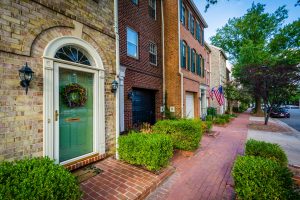
Regarding the existing building energy code proposals, the discussion centered around where the proposals should live within the USBC. Some code officials argued that they should live solely in the Existing Building (VEBC) section of the USBC, while other officials argued they should live in both the energy conservation codes and the VEBC. Another issue was that several proposals that attempted to strike existing building language from the energy conservation code actually weakened existing requirements. A small subset of subgroup members will work together to come up with a solution that works for everyone prior to the next subgroup meeting. As long as the existing energy code requirements remain intact, VAEEC does not have a position on which chapter is the right place for these proposals to live.
The proposal on insulation would have brought Virginia’s code up to the 2012 model code requirements. This proposal was opposed by the Homebuilders Association of Virginia, so it was marked as non-consensus. Their arguments were that it would “price someone out” of the market, that codes should be a minimum, and that there would be diminishing returns despite the proposal impact statement stating that this change would garner 6% in energy savings for homeowners, which is the greatest energy savings of any single proposal. We are disappointed that this proposal is moving forward as non-consensus, which effectively kills the proposal.
While we are pleased that the air leakage proposal did not suffer the same fate as the insulation proposal, the debate was just as spirited. VAEEC member Viridiant presented the initial findings from DOE Field Study they conducted in conjunction with another VAEEC member, Southeast Energy Efficiency Alliance, which highlighted that 25% of new homes being built to code are failing to meet the five air changes per hour requirement in the current USBC. If I could read the tea leaves, I think it might be possible for the blower door test to become part of the next USBC update, but the change from five air changes per hour to three will not move forward.
Next up were the two window fenestration proposals, which would bring the USBC up to the model code standard. While the window replacement proposal moved forward with consensus, the commercial proposal was concerning to the Apartment and Office Building Association (AOBA) due to implications for multi-family units. The AOBA official is taking the proposal back to his membership for review and will provide feedback at the next meeting.
The last two proposals were more administrative in nature. Because of some of the weakening amendments in Virginia’s code, Virginia builders, designers, and contractors cannot use the DOE REScheck software, to ensure code compliance on new construction, additions, or renovations. One of the proposals would remove language that refers Virginia builders, designers, and contractors to guidance documents DHCD has offered as an alternative. However, other proposals, such as the insulation and window fenestration proposals, would need to be approved as well. The other administrative proposal would require a permanent certificate within the structure, which would provide details on the thermal envelope, including insulation ratings and window U-values. VAEEC member Think Little explained that this would be extremely helpful in their work when they are working with a client to replace their HVAC system. Typically, they have to guess many of these data points, which could cause them to incorrectly size the new HVAC system. There was a lengthy discussion on where the certificate should be housed- particularly as it pertains to multi-family and commercial buildings. A smaller group of attendees are going to work out the details prior to the next subgroup meeting. This proposal should eventually move forward with consensus.
The subgroup will meet once more in early to mid summer to continue discussions on the remaining proposals and to determine if consensus can be reached on any of them before the proposals are reviewed by the workgroup. All workgroup activities will wrap up by the end of the summer. After that, all proposals will be reviewed by the DHCD Board who will then vote on all of the proposals that went through the workgroup process. All proposals approved by the DHCD Board will form the draft USBC, which will be reviewed and voted upon in the fall. The draft USBC will then go to the Virginia Register for a public comment period, and the process will begin all over again next year.
*You can visit the main building codes page on the VAEEC website to learn more about the development of the federal model code as well as the Virginia update process.
The Spring 2019 Forum was held on May 9th at the University of Richmond Jepson Alumni Center. Almost 100 people from every facet of the energy efficiency industry attended, making it one of our most successful events to date! We want to offer a huge thank you to our sponsors for their support, and to everyone who came to the Forum.
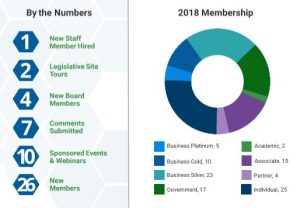
Executive Director Chelsea Harnish formally opened the event with her annual presentation on VAEEC’s accomplishments and updates. Many of the 2018 highlights are in our annual report, which you can view here. She also discussed the incredible momentum VAEEC and the industry as a whole is gaining. The SCC Final Order approving all 10 of Dominion’s proposed energy efficiency programs is a big part of this progress, as is the C-PACE budget recently passed in Alexandria.
Next, Vice Chair John Morrill, with Arlington County, introduced the current Executive Committee and recognized the service of Bill Greenleaf and Cynthia Adams as they transition off of the Board of Directors, as well as David Steiner for stepping down as the Board Chair. Before electing new Board members, John announced the VAEEC 2019 Executive Committee: David Koogler, Board Chair; John Morrill, Vice Chair; and Mark Jackson, Secretary.
VAEEC members re-elected three Board members:
- Mark Jackson of Community Housing Partners
- Susan Larsen of Columbia Gas of Virginia
- Tom Nicholas of the City of Virginia Beach
They also elected five new Board members:
- Elizabeth Beardsley of USGBC
- KC Bleile of Viridiant
- Rick Counihan of Google
- Bill Eger of the City of Alexandria
- Stephen Evanko of Dominion Due Diligence Group
We are excited to add these new voices to our organization as we move into this year’s strategic planning process.
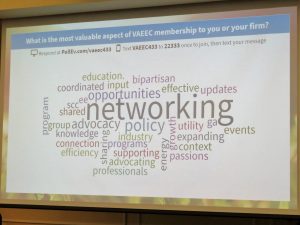
Next, Tom Nicholas with City of Virginia Beach and Chair of the Membership Committee, lead the Membership Spotlight session and Membership Poll. Following last year’s positive reception, we used PollEverywhere to collect real-time responses to our four questions:
- What is the most valuable aspect of VAEEC membership to you or your firm?
- What additional benefits would you like to see included in VAEEC membership?
- Would you like VAEEC events to offer continuing education credits?
- What topics would you like to see covered at our Fall 2019 Forum?
Representatives from 2RW Consultants, Think Little, Community Housing Partners, VEIC, Viridiant, Dominion Energy, C-Power, LEAP, City of Virginia Beach, and Trane all shared their accomplishments during the spotlight session, so make sure to check out our Member Success Stories page in the coming weeks. We appreciate everyone’s participation in both the poll and spotlight and will incorporate the information gathered into our future plans.
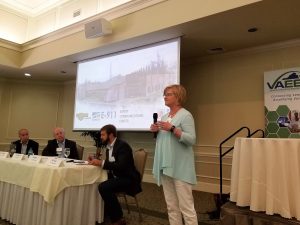
After the Membership Spotlight, participants attended one of two breakout sessions: Blending Technologies to Maximize Building Efficiency and Working Together to Increase Efficiency. The Blending Technologies panel featured Eric Oliver (2RW Consultants, Inc.), Rodes Boyd (Siemens), and Nick Lange (VEIC) with George Barnes (Trane) moderating. The speakers discussed the benefits and challenges surrounding current and upcoming smart building technologies that monitor energy usage and identify areas of waste.
The Working Together session focused on how local governments and higher education institutions can cooperate across departments to increase energy efficiency and incorporate successful IT solutions. Chris Smeds (UVA), Nell Boyle (City of Roanoke), and John Morrill (Arlington County) formed the panel of speakers, with Bill Eger (City of Alexandria) moderating.
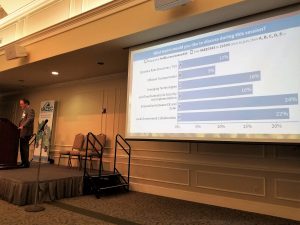 The final session of the day was an interactive session where participants chose four topics to discuss, then split into groups to consider the opportunities and barriers for each, as well as the role VAEEC could play in that work. The topics were:
The final session of the day was an interactive session where participants chose four topics to discuss, then split into groups to consider the opportunities and barriers for each, as well as the role VAEEC could play in that work. The topics were:
- Emerging Technologies
- Grid Modernization and Transformation Act Implementation
- The Intersection between Solar and Energy Efficiency
- Local Government Collaboration
The information we gathered from this session (view summary here) will form the foundation of our upcoming strategic plan, so everyone’s participation and feedback were truly invaluable.
As with all of our work, the Spring Forum would not be possible without the continuing support of our incredible members and sponsors. Thank you to everyone who attended for helping us push energy efficiency in Virginia toward an even brighter future.
Presentations can be viewed here:
Please share our event photos across your social media networks!
We are now one month away from the Spring 2019 Forum! It will be similar to our past events that you have come to enjoy, just with a new name to better represent the content and overall quality that our attendees expect.
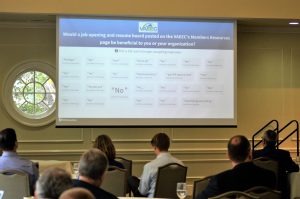
Attendees respond to live poll during Spring 2018 Meeting
The Forum will be held on May 9th at the University of Richmond in the Jepson Alumni Center from 1:00 to 5:00 pm. Plan to arrive at 12:30 pm for registration and extra networking time. We will kick things off with a business meeting, where members will participate in our 2019 Board Elections. Then, back by popular demand, we will issue a live poll to get your feedback on how we can make the VAEEC even more beneficial to our members. Not yet a member? That’s ok; we want your feedback too. Let us know what it will take for you to join our membership network.
This year’s breakout sessions are Blending Technologies to Maximize Building Efficiency and Working Together to Increase Efficiency. The technologies panel will discuss how to achieve the right “blend” of old and new technologies to reduce energy use, as well as “future proofing”, or implementing technologies that allow buildings to keep up with the digital era. The working together panel will feature local government representatives and a higher education staff member who will discuss successful interactions between different departments to increase energy efficiency and to bring it into the IT realm. Join either session to learn and brainstorm how energy efficiency can advance even further in Virginia.
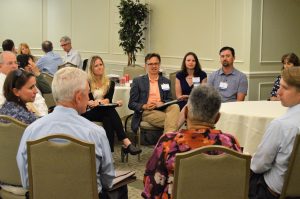
Breakout group discusses priorities and strategies for the year
Our final session of the day will be a collaborative, interactive session providing you the chance to influence VAEEC’s work for the coming years. Similar to last year, attendees will self-select and join one of several breakout groups to discuss a variety of topics, such as local government collaboration and data access and smart meters. But new this year, attendees will get to select the topics discussed from a pre-screened list of ideas! Recommendations and goals shared during this time will be used to lay the groundwork for the organization’s three-year strategic plan this summer. We can’t wait to hear your thoughts!
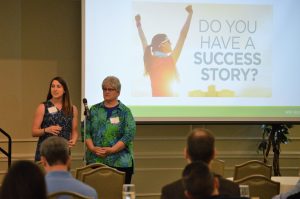
project:HOMES shares the success of their legislative site tour with VAEEC
One of the many benefits of a VAEEC membership is the chance to showcase your successes! During the Remarkable Member Updates portion of the event, all current VAEEC members are invited to speak for up to a minute about any accomplishments you have achieved over the past year. Email info@vaeec.org by May 7th to secure your spot. We also invite all members to display your business cards and marketing materials on our Member Networking table, which will be conveniently located next to registration for all to see.
Finally, don’t forget to register! Registration closes Tuesday, April 30th. The event is free for VAEEC members and $25 for non-members. Interested in becoming a member? Go to our Join page to learn how a VAEEC membership will benefit you and your organization. We look forward to seeing you on May 9th!
 Residential homeowners looking to make their home more energy efficient in preparation for winter and beyond can benefit from the launch of Dominion Energy Virginia’s new Home Energy Assessment (HEA) Program.
Residential homeowners looking to make their home more energy efficient in preparation for winter and beyond can benefit from the launch of Dominion Energy Virginia’s new Home Energy Assessment (HEA) Program. The HEA Program was designed with three simple steps to make it easy to participate:
The HEA Program was designed with three simple steps to make it easy to participate:




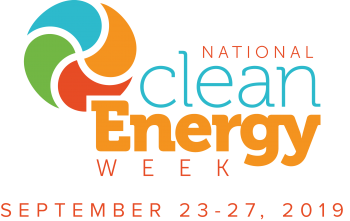









/cdn.vox-cdn.com/uploads/chorus_image/image/53974235/usa_today_9234991.0.jpg) Baseball fans and Washington D.C. natives alike will be familiar with the home to the MLB team, the Washington Nationals. Nationals Park has the distinction of being the
Baseball fans and Washington D.C. natives alike will be familiar with the home to the MLB team, the Washington Nationals. Nationals Park has the distinction of being the 




 The update process to the Virginia Uniform Statewide Building Code (USBC) has begun*. This is a two year process, which will wrap up at the end of 2020. The Board of Housing and Community Development will hold a public hearing on July 22, 2019 and we encourage our members to attend in support of improvements to the energy code section of the USBC.
The update process to the Virginia Uniform Statewide Building Code (USBC) has begun*. This is a two year process, which will wrap up at the end of 2020. The Board of Housing and Community Development will hold a public hearing on July 22, 2019 and we encourage our members to attend in support of improvements to the energy code section of the USBC.
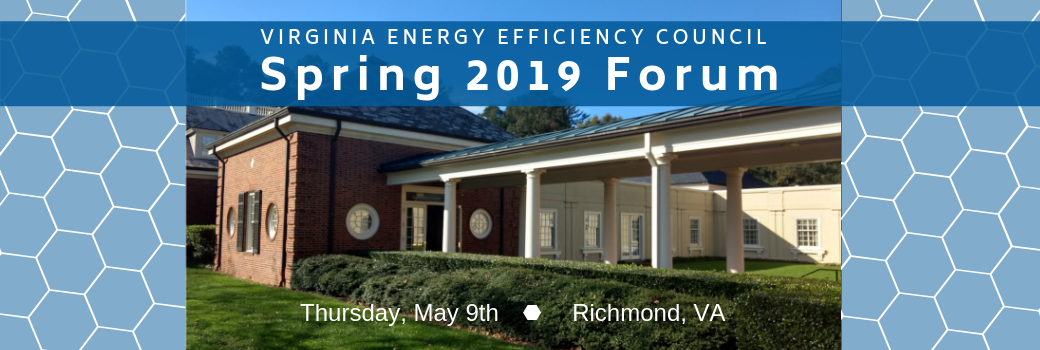



 The final session of the day was an
The final session of the day was an 